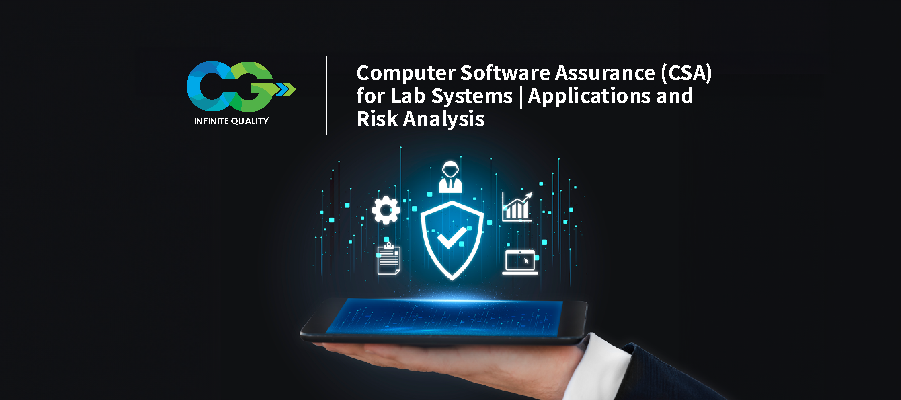Computer Software Assurance (CSA) for Lab Systems | Applications and Risk Analysis

Article Context:
- Computer Software Assurance
- Applications of Computer Software Assurance(CSA) for Lab Systems
- Computer Software Assurance (CSA) Risks for Lab Systems
The significance of FDA Computer Software Assurance (CSA) cannot be overstated when it comes to laboratory systems in today's technological era. Embracing the CSA methodology is crucial as it promotes the use of critical thinking and digital technology, prioritizing them over burdensome testing and documentation processes. This approach ensures the quality of products and the safety of patients, aligning with the regulatory standards set by the FDA, particularly 21 CFR Part 58, which prescribes good laboratory practices for nonclinical laboratory studies (source: FDA).
Implementing CSA for lab systems offers several benefits, including faster deployment and a higher return on investment (ROI) by streamlining the validation process. While rigorous validation remains necessary for more high-risk applications, Computer Software Assurance FDA (CSA) represents the future and a superior technique for achieving compliance. One may wonder about the differences between Computer System Validation (CSV) and CSA since they appear quite similar. However, the buzz surrounding CSA is due to its emphasis on assurance requirements, which are the second most important aspect of the new CSA technique proposed in CFR 21 Part 58, right after critical thinking. CSA lab systems encourage the use of ad hoc testing and other unscripted techniques, as well as automated testing approaches. The underlying concept is that producing excessive documentation does not necessarily enhance the validation process; instead, a more effective validation can be achieved through these testing methods. Contrary to popular belief, the FDA states that excessive documentation is not only unnecessary but also detrimental.
CSA represents a risk management framework and a lab-based approach to safeguarding information systems. By embracing this methodology, you can ensure the security and integrity of your lab systems while complying with FDA regulations.
Applications of Computer Software Assurance (CSA) for Lab Systems
Emphasizing critical thinking and targeted testing, the CSA risk management guidelines pave the way for a shift in software validation practices. The forthcoming CSA guidance is expected to reduce out-of-the-box functionality testing and emphasize User Acceptance Testing (UAT), where users evaluate their business processes and the intended use of the system.
The software’s intended usage can be identified
Identifying the software's intended usage is a key step as outlined in FDA 21 CFR Part 58. The Computer Software Assurance risk management approach begins by determining the specific application or feature for the software. If a system directly impacts patient safety, device quality, or quality system integrity (e.g., software integrated into the device, electronic device history, adverse event reporting), it is classified as a direct system. Otherwise, it falls into the category of an indirect system (e.g., lifecycle management software).
Risk can be prioritized
Prioritizing risk requires applying critical thinking to devise a validation approach that aligns with the system's level of risk. The FDA acknowledges your expertise and control over your products and processes, understanding that you possess the best insights into how risk factors into your products. It is crucial to provide detailed descriptions of where risk is introduced so that auditors can comprehend your story. Distinguishing between areas where the system may introduce risk and areas where process-related risk exists is essential for assessing the impact on patient safety and product quality. It's important to note that a system is only considered "low risk" if its failure does not affect patient safety or product quality. Failing to accurately assess risk can lead to misleading outcomes.
Vendor documentation can be leveraged
Leveraging vendor documentation becomes beneficial for medium-risk and low-risk features when they possess robust documentation and validation processes. If the software has undergone substantial validation by the vendor and is considered "out of the box," rigorous validation methods and extensive documentation may not be necessary. This practice aligns with the requirements outlined in 21 CFR Part 58 Good Laboratory Practices (GLP).
Activities can be decided after detecting the risk
For high-risk (direct) software and features, comprehensive validation activities and documentation will still be essential. This entails establishing test objectives, step-by-step test procedures, expected outcomes, pass/fail criteria, and thorough documentation. Medium-risk features may often be adequately addressed using vendor documentation or unscripted testing, which includes test objectives and pass/fail assessment without a detailed step-by-step procedure. As for indirect systems that do not impact safety or product quality, vendor documentation or, in some cases, minimal to no validation may suffice.
Risks of Computer Software Assurance (CSA) for Lab Systems
The process of managing risk in the information lab systems answers a lot of questions about the recent technology. There are some lab system risks related to product quality and patient safety. Software is not a tangible object; it is developed, is made up of lines of code, and cannot be observed or measured. According to the CSA approach, risks and effects on patient safety and product quality must be evaluated for the required complexity. Patient safety may be impacted by product quality, and ultimately, the patient not the manufacturer is the intended user. What effect does the software's performance of a specific feature or function have on patients and how does it affect the final product's quality? To help with the creation of a risk-based assurance strategy, FDA advises manufacturers to assess the intended applications of the various features, functions, and processes. Manufacturers may opt to carry out various assurance procedures for certain features, processes, or functionalities.
Conclusion
With a strong focus on patient safety, product quality, risk management, and critical thinking, the new CSA guidelines represent a significant shift from the previous CSV framework. The FDA recognizes the need to address these important aspects, leading to the development of CSA as an alternative approach. Unlike CSV, which heavily relies on documentation, CSA prioritizes critical thinking as the primary phase. This innovative methodology brings numerous benefits, including accelerated software development and implementation, cost savings, reduced paperwork, and more efficient software systems.
To fully grasp the intricacies of CSA, it is crucial to thoroughly examine the complete a 21 CFR Part 58 audit checklist. This checklist serves as a valuable resource for understanding the requirements and ensuring compliance with CSA guidelines. CSA plays a vital role in laboratory systems and applications, as it guarantees compliance, security, and reliability of the software utilized in laboratory settings. By promoting regulatory compliance, CSA addresses the specific risks and challenges associated with lab software, ensuring data integrity, and minimizing errors. From risk analysis to documentation, validation, and monitoring, Compliance Group offers comprehensive CSA solutions designed to enhance the performance of your lab system while mitigating risks, including the unique considerations in a GLP environment.
By embracing CSA for your lab system applications, performance assessment, and risk analysis, you can stay ahead of the curve and gain a competitive edge. Elevate your applications to new heights with our expertise and experience. Contact us today to explore how our CSA solution can transform your lab system into a powerhouse of compliance and innovation, enabling you to lead the way in your industry.
For more information, contact sales@complianceg.com.
FAQ's
What is the risk-based approach to CSA?
It uses a customised approach to risk management and testing to assist build trust in system performance and operation. This entails greater tool use, exploratory, unscripted, and limited scripted testing, automation, and supplier documentation utilisation to help reduce duplication of work.
What are the three approaches to risk management?
The three aspects of risk management include risk identification /assessment (what could go wrong and when), risk management / control (implementing design controls to reduce poor outcomes and testing the strategies to control risk work) and risk monitoring (creating methods to measure and identify when failures occur to ensure a continuous improvement program is followed).
What are the three standard approaches for dealing with risk threats?
Risk evolves and as we learn more and more about the systems we implement and support, the concept of risk changes. The four basic ways of dealing with a risk include: avoidance (designing the system or business process to circumvent the risk), mitigation (creating alerts or enhancing the business process to prevent the risk from occurring), and acceptance (sometimes you must live with risk; ensure your organization tracks the risk for potential future elimination or addresses any potential ways to minimize the risk impact).
What are the two main approaches to risk analysis?
The qualitative and quantitative methods are the two basic techniques of risk analysis. Qualitative risk analysis provides a broad understanding of risks and helps prioritize them based on their perceived impact. On the other side, quantitative risk analysis involves assigning numerical values to risks. It utilizes statistical techniques, data analysis, and probability calculations to quantify the likelihood of risk occurrence and estimate the potential impact. In CSA for a GLP system, this could include measuring the function type (data acquisition versus data analysis) and measuring that against the requirement’s complexity (standard, configured, custom) to determine the risk level.
AUTHOR:
STEPHEN J COOK
VP – Validation Quality & Compliance

